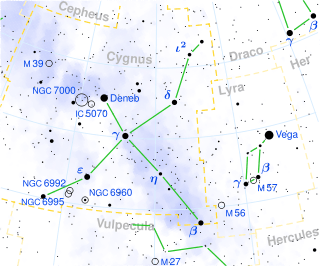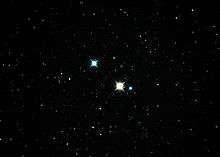31 Cygni
- For other star systems with this Bayer designation, see Omicron Cygni.

| |
| Observation data Epoch J2000.0 Equinox J2000.0 | |
|---|---|
| Constellation | Cygnus |
| Right ascension | 20h 13m 37.907s[1] |
| Declination | +46° 44′ 28.78″[1] |
| Apparent magnitude (V) | 3.73 - 3.89[2] |
| Characteristics | |
| Spectral type | K4Iab + B4IV-V[2] |
| Variable type | Algol[2] |
| Astrometry | |
| Radial velocity (Rv) | –7.41 ± 0.08[3] km/s |
| Proper motion (μ) | RA: 4.78 ± 0.38[1] mas/yr Dec.: 1.21 ± 0.35[1] mas/yr |
| Parallax (π) | 3.69 ± 0.41[1] mas |
| Distance | approx. 880 ly (approx. 270 pc) |
| Orbit[3] | |
| Period (P) | 3786.1 ± 0.7 days |
| Eccentricity (e) | 0.224 ± 0.006 |
| Periastron epoch (T) | 2,452,372.8 ± 2.2 |
| Argument of periastron (ω) (secondary) | 206.4 ± 1.4° |
| Semi-amplitude (K1) (primary) | 13.78 ± 0.13 km/s |
| Details | |
| K supergiant | |
| Mass | 11.7[4] M☉ |
| Radius | 197[4] R☉ |
| Luminosity | 4,300[5] L☉ |
| Temperature | 3,590[5] K |
| B dwarf | |
| Mass | 7.1[4] M☉ |
| Radius | 5.2[4] R☉ |
| Temperature | 16,500[5] K |
| Other designations | |
| Database references | |
| SIMBAD | data |

31 Cygni, also known as ο1 Cygni, Omicron1 Cygni, or V695 Cygni, is a star in the constellation Cygnus.
The Bayer letter ο has been variously applied to two or three of the stars 30, 31, and 32 Cygni. 31 Cygni has been designated as either ο1 or ο2 Cygni. For clarity, it is preferred to use the Flamsteed designation 31 Cygni rather than one of the Bayer designations.[6]
It is an Algol-type eclipsing binary and ranges between magnitudes 3.73 and 3.89 over a period of ten years. The component stars are an orange supergiant of spectrial type K4Iab and a blue-white star likely to be evolving off the main sequence with a spectral type of B4IV-V.
ο2 Cygni is about a degree away to the north, also a detached eclipsing binary system containing a cool giant and a small hot star. 30 Cygni is another naked eye star a tenth of a degree away from the 31 Cygni pair, forming a bright triple.
References
- 1 2 3 4 5 van Leeuwen, F. (2007). "Validation of the new Hipparcos reduction". Astronomy and Astrophysics. 474 (2): 653–664. arXiv:0708.1752
 . Bibcode:2007A&A...474..653V. doi:10.1051/0004-6361:20078357.Vizier catalog entry
. Bibcode:2007A&A...474..653V. doi:10.1051/0004-6361:20078357.Vizier catalog entry - 1 2 3 Samus, N. N.; Durlevich, O. V.; et al. (2009). "VizieR Online Data Catalog: General Catalogue of Variable Stars (Samus+ 2007-2013)". VizieR On-line Data Catalog: B/gcvs. Originally published in: 2009yCat....102025S. 1. Bibcode:2009yCat....102025S.
- 1 2 Eaton, Joel A.; et al. (2008). "Orbits and Pulsations of the Classical ζ Aurigae Binaries". The Astrophysical Journal. 679 (2): 1490–1498. arXiv:0802.2238
 . Bibcode:2008ApJ...679.1490E. doi:10.1086/587452.
. Bibcode:2008ApJ...679.1490E. doi:10.1086/587452. - 1 2 3 4 Eaton, Joel A. (1993). "31 Cygni: The B star and the wind". Astronomical Journal. 106: 2081. Bibcode:1993AJ....106.2081E. doi:10.1086/116787.
- 1 2 3 Di Benedetto, G. P.; Ferluga, S. (1990). "Angular diameters of Zeta Aurigae-type supergiants by Michelson interferometry". Astronomy and Astrophysics. 236: 449. Bibcode:1990A&A...236..449D.
- 1 2 Kostjuk, N. D. (2004). "VizieR Online Data Catalog: HD-DM-GC-HR-HIP-Bayer-Flamsteed Cross Index (Kostjuk, 2002)". VizieR On-line Data Catalog: IV/27A. Originally published in: Institute of Astronomy of Russian Academy of Sciences (2002). 4027. Bibcode:2004yCat.4027....0K.